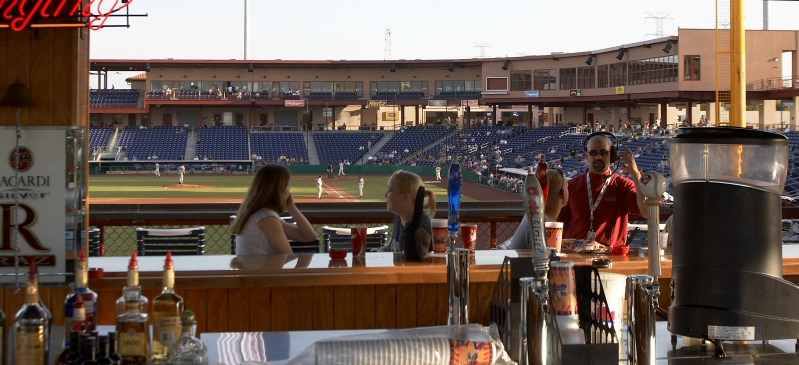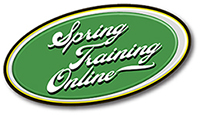
As we’ve been focused on schedules and lockouts this spring, we’ve put off the significance of spring training in 1947, as we celebrate the 75th anniversary of some of the most important milestones in both spring training and baseball history.
In 1947, Jackie Robinson was entering his second year in affiliated ball after spending the 1946 season with the Montreal Royals. Robinson’s MiLB training season, which began in Sanford and ended in Daytona Beach (the old Sanford ballpark is long gone, but the Daytona ballpark is now known as Jackie Robinson Ballpark), was marked by plenty of racial clashes, including local sheriffs ordering Robinson off the field and cities closing their ballparks rather than let Robinson and the Royals play another MiLB team.
Still, after a solid 1946 season, it was clear Robinson was ready for the bigs—and society was ready for Robinson. Trying to create fewer distractions for Robinson and the Dodgers, Branch Rickey made the decision to hold training camp in Havana, Cuba. It was an expensive decision, to be sure, but it did accomplish the main goal of cutting down on external distractions.
The Dodgers played spring games at Gran Stadium—better known then as Gran Estadio de La Habana, and today as Estadio Latinoamericano (still standing, but since renovated and expanded). At the time it was a spanking-new facility, opening in 1946 with a capacity of 31,000. Housed at the Hotel Nacional, most of the Dodgers trained under first-class conditions, a situation copied by Rickey when later designing Vero Beach’s Dodgertown. (In a misstep from Rickey, the Black players on the Dodgers roster, including Don Newcombe and Roy Campanella, stayed at the inferior Hotel Boston.) The New York Yankees and Boston Braves visited Gran Stadium, but crowds did not follow, and after a single year the Dodgers abandoned the Cuban experiment. (Who drew in Cuba in spring 1947? The women of the All-American Girls Professional Baseball League, who also trained in Cuba and played games against Cuban women pro baseball players.) The Dodgers trained in 1948 in the Dominican Republic and the minor leaguers in Vero Beach, before totally committing to Dodgertown.
All that, really, was trivial when compared to the real history made in 1947: Robinson’s shattering of MLB’s color line on April 15, 1947.
While other 1947 spring-training developments are worth noting, they do pale in comparison to Robinson’s accomplishments. For instance, the roots of today’s Cactus League formed in 1947 when the New York Giants moved spring training to Phoenix and the Cleveland Indians to Tucson. Before World War II spring training was a distinctly different affair, with relatively few local games and plenty of barnstorming between training sites and home cities. It was not unheard of for teams to train in the West before the Cactus League—the Detroit Tigers trained in Phoenix in 1929, Sacramento in 1931 and Palo Alto in 1932 before committing to Lakeland in 1934, and the Chicago Cubs famously trained on Catalina Island. Those 1947 games between Horace Stoneham’s New York Giants and Bill Veeck’s Cleveland Indians are now considered the beginning of the modern Cactus League.
And, finally, we are celebrating the 75th anniversary of the Philadelphia Phillies training for the first time in Clearwater, one of the longest-lasting relationships between a city and an MLB team in spring history. (Older: the Detroit Tigers have been training in Lakeland since 1934, save the 1943-1945 war years, first at Henley Field and then at Joker Marchant Stadium.) The team’s 1947 home, Athletic Field, was not exactly the lap of luxury, even by the conditions of the day: the 3,000-seat venue featured a rough playing field sporting more sea shells than blades of grass. The Phillies served notice that Athletic Field was not a long-term contender to keep the team, especially in an era where MLB teams often shifted spring-training venues annually.
Jack Russell, a Clearwater city commissioner who happened to be a former MLB pitcher, pushed the city to build a new ballpark for the Phillies. That finally happened in 1955, when the Phillies moved into what would be named Jack Russell Stadium. It served as the spring home of the Phillies until 2004, when BayCare Ballpark opened. Though the Jack Russell Stadium grandstand was torn down, the playing field remains, along with newer seating. You’ll still see youth and college baseball at the site. But if you’re visiting, bring along a ball and glove; in the instance where there’s no action on the field, you’re free to play catch where Larry Bowa, Mike Schmidt and Steve Carlton prepped for the greatest years of their careers.

Comments are closed.